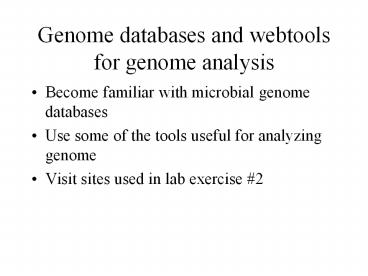Genome databases and webtools for genome analysis - PowerPoint PPT Presentation
Title:
Genome databases and webtools for genome analysis
Description:
Online Mendelian Inheritance in Man. Database that links diseases and genes. TIGR ... Most automated annotation engines have ORF finding capabilities. ... – PowerPoint PPT presentation
Number of Views:147
Avg rating:3.0/5.0
Title: Genome databases and webtools for genome analysis
1
Genome databases and webtools for genome analysis
- Become familiar with microbial genome databases
- Use some of the tools useful for analyzing genome
- Visit sites used in lab exercise 2
2
Major components of NCBI
- GenBank
- PubMed
- Entrez
- BLAST
- Conserved Domain Database (CDD)
- Cluster of orthologous groups (COGS)
- OMIM
3
GenBank
- Database of DNA and protein sequences
- Searchable
- Caution Sequences deposited by the community,
not curated for accuracy. - RefSeq - verified by NCBI.
4
Example of a GenBank record
5
BLAST
- Basic Local Alignment Search Tool
- Comparing nucleotide sequences and protein
sequences - Microbial specific BLAST page
- Focus of a future lab
6
OMIM
- Online Mendelian Inheritance in Man.
- Database that links diseases and genes
7
TIGR
- Comprehensive microbial resource (CMR).
- Many genomes.
- Tools to analyze genomes.
8
SubtiList
- Website for B. subtilis genome.
- Features
- Annotated genes
- Gene region display
- Updated similarity searches for every protein
- BLAST and pattern search capabilities
- Links to journal articles and protein databases
9
RDP
- Ribosomal database project
- Curated at MSU
- Contains a compilation of all ribosomal DNA
sequences (currently over 100,000). - Second database contains information regarding
copy number of ribosomal RNA.
10
KEGG
- Kyoto Encyclopedia of Genes and Genomes
- Often changing database of gene content,
metabolic pathways, etc. - Excellent resource for reconstructing pathways in
organism of interest.
11
Genome sequencing and annotation
Week 2 reading assignments - pages 65-79,
110-122. Boxes 2.1, 2.2 and 2.3. Dont worry
about the details of HMM. Hughes Functional
Genomics Review.
12
- Sequencing - dideoxy method for DNA sequencing.
- Methods for sequencing genomes.
- Methods for finding and annotating genes in
microbial genomes.
13
Dideoxy sequencing (Sanger method)
- Developed by Frederick Sanger (for which he won
his second Nobel Prize in 1980).
14
(No Transcript)
15
Two types of labeling
- Radioactive
- 32P, 35S
- Run out each dideoxy base in a separate reaction,
lane on a gel. - No longer used
- Fluorescent
- Four different fluorophores for each base
- Can be mixed.
- Chromatograms - GTSF
16
Cycle sequencing
17
Phred
- Method for automated quality assessment of DNA
sequence traces. - Variance in peak spacing in 7 peak window
- Ratio of largest uncalled peak to smallest called
peak in 7 and 3 peak windows. - Number of bases between current base and nearest
unresolved base. - Phred score 10 x (-log(P)).
- Phred scores of 20 or higher are considered good
calls. Why?
18
Sequencing of genomes
- Hierarchical or contig based sequencing
- Clone smaller segments of the genome.
- Labor intensive, slow
- Not needed for sequencing microbial genomes
- Shotgun method
- Randomly clone and sequence 1.5-2 kb fragments of
DNA. 5-10 fold coverage. - Computationally intensive.
19
Finding genes in a genome sequence
- What to look for?
- Glimmer - HMM algorithm for identifying genes.
(TIGR). - ORF finder - NCBI.
- Most automated annotation engines have ORF
finding capabilities. - Much more difficult in eukaryotic genomes.































